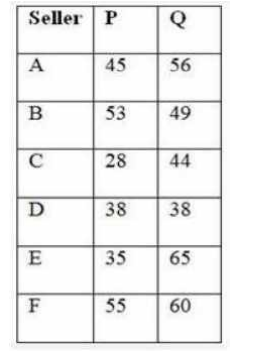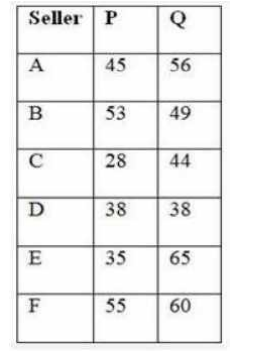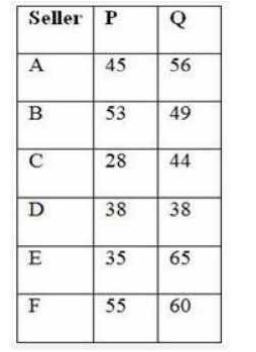The Table shows the number of articles sold by six different sellers (A, B, C, D, E and F) to two different shopkeepers P and Q. Some articles are purchased by other sellers also. Total articles purchased by shopkeepers P and Q is 300 and 500 respectively.

Total number of articles sold by seller C to shopkeeper Q is what percent of total number of articles sold by seller F to shopkeeper P?
0.75
0.84
0.78
0.8
The correct Answer is:A
Step by step video, text & image solution for The Table shows the number of articles sold by six different sellers (A, B, C, D, E and F) to two different shopkeepers P and Q. Some articles are purchased by other sellers also. Total articles purchased by shopkeepers P and Q is 300 and 500 respectively. Total number of articles sold by seller C to shopkeeper Q is what percent of total number of articles sold by seller F to shopkeeper P? by Maths experts to help you in doubts & scoring excellent marks in Class 14 exams.
Similar Questions
The Table shows the number of articles sold by six different sellers (A, B, C, D, E and F) to two different shopkeepers P and Q. Some articles are purchased by other sellers also. Total articles purchased by shopkeepers P and Q is 300 and 500 respectively.
यह तालिका छः अलग-अलग विक्रेताओं ( A, B, C, D, E और F ) के द्वारा दो दुकानदारों (P और Q) को बेची गयी वस्तुओं की संख्या दर्शाती है | कुछ वस्तुएँ अन्य विक्रेताओं के द्वारा भी ख़रीदी जाती हैं | दुकानदार P और Q के द्वारा ख़रीदी गयी कुल वस्तुओं की संख्या क्रमशः 300 और 500 है | Total number of articles sold by seller C to shopkeeper Q is what percent of total number of articles sold by seller F to shopkeeper P’?
Total number of articles sold by seller C to shopkeeper Q is what percent of total number of articles sold by seller F to shopkeeper P’?
विक्रेता C के द्वारा दुकानदार Q को बेची गयी वस्तुओं की कुल संख्या विक्रेता F के द्वारा दुकानदार P को बेची गयी वस्तुओं की कुल संख्या का कितना प्रतिशत है ?View SolutionThe Table shows the number of articles sold by six different sellers (A, B, C, D, E and F) to two different shopkeepers P and Q. Some articles are purchased by other sellers also. Total articles purchased by shopkeepers P and Q is 300 and 500 respectively.
यह तालिका छः अलग-अलग विक्रेताओं ( A, B, C, D, E और F ) के द्वारा दो दुकानदारों (P और Q) को बेची गयी वस्तुओं की संख्या दर्शाती है | कुछ वस्तुएँ अन्य विक्रेताओं के द्वारा भी ख़रीदी जाती हैं | दुकानदार P और Q के द्वारा ख़रीदी गयी कुल वस्तुओं की संख्या क्रमशः 300 और 500 है | What is the difference between total articles sold to P and Q by all the sellers other than A, B, C,
D, E and F?
What is the difference between total articles sold to P and Q by all the sellers other than A, B, C,
D, E and F?
A, B, C, D, E और F के अलावा अन्य विक्रेताओं के द्वारा P और Q को बेची गयी वस्तुओं की कुल संख्या में क्या अंतर है ?View Solution
Knowledge Check
- Question 1 - Select One
If an article is sold for Rs 550 then the profit is 10%. At what price should the article be sold to make 10% loss?
ARs 450BRs 460CRs 300DRs 470 - Question 2 - Select One
When the price of an article is increased by 15% the number of articles aold decreases by 20% What is the percentage change in the sales revenue? (Sales revenue = piece of each article X number of articles sold).
A5% increaseB3% decreaseC8% increaseD8% decrease - Question 3 - Select One
When the price of an article is increased by 15% the number of articles aold decreases by 20% What is the percentage change in the sales revenue? (Sales revenue = piece of each article X number of articles sold).
A5% increaseB3% decreaseC8% increaseD8% decrease
The Table shows the number of articles sold by six different sellers (A, B, C, D, E and F) to two different shopkeepers P and Q. Some articles are purchased by other sellers also. Total articles purchased by shopkeepers P and Q is 300 and 500 respectively.
यह तालिका छः अलग-अलग विक्रेताओं ( A, B, C, D, E और F ) के द्वारा दो दुकानदारों (P और Q) को बेची गयी वस्तुओं की संख्या दर्शाती है | कुछ वस्तुएँ अन्य विक्रेताओं के द्वारा भी ख़रीदी जाती हैं | दुकानदार P और Q के द्वारा ख़रीदी गयी कुल वस्तुओं की संख्या क्रमशः 300 और 500 है | What is the average number of articles sold to the shopkeeper P by the sellers A, B, C and D together ?
What is the average number of articles sold to the shopkeeper P by the sellers A, B, C and D together ?
दुकानदार P को विक्रेताओं A, B, C और D के द्वारा कुल मिलाकर बेची गयी वस्तुओं की संख्या का औसत क्या है?View Solution
Number of Redmi cellular sold by store R is what percent more than the total number of Samsung cellular phones sold by stores P and Q together ?View Solution
The total number of sold by P and Q together on Wednesday is how much percentage more than the number of mobiles sold by P and Q together on Tuesday ?View SolutionIf 6 articles are sold for Rs 1 then there is a loss of 20%. In order to gain 20%, what must be the number of articles sold for Rs 1 ?
View SolutionThe cost of an article is Rs. 500 and on selling it, the shopkeeper got 6.4% profit. Find the selling price of article.
View Solution

